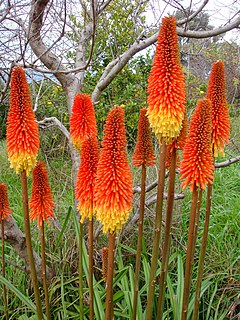| Cyphia | |
|---|---|
 | |
| Cyphia digitata | |
| Scientific classification | |
| Kingdom: | Plantae |
| Clade: | Tracheophytes |
| Clade: | Angiosperms |
| Clade: | Eudicots |
| Clade: | Asterids |
| Order: | Asterales |
| Family: | Campanulaceae |
| Subfamily: | Cyphioideae |
| Genus: | Cyphia P.J.Bergius |
| Type species | |
| Cyphia bulbosa (L.) Bergam. | |
| Synonyms [1] | |
| |
Cyphia is a genus of flowering plants in the bellflower family, native to Africa; and particularly South Africa. [1] [2] [3] It has been placed in its own subfamily, Cyphioideae. [4] It is closely related to the genus Lobelia. [3] Cyphia comes in shades of white to mauve, whereas lobelias have strong colours of blue to purple. [3] Species in this genus have a bilabiate corolla; with 3 lobes on top and 2 below (as opposed to Lobelia, which has 2 lobes on top and 3 below). [3]
Accepted species: [1]
- Cyphia alba N.E.Br. – Zimbabwe
- Cyphia alicedalensis E.Wimm. in H.G.A.Engler – South Africa
- Cyphia angustifolia Eckl. & Zeyh. ex C.Presl in C.F.Eklon & K.L.P.Zeyher – South Africa
- Cyphia aspergilloides E.Wimm. – South Africa
- Cyphia basiloba E.Wimm. in H.G.A.Engler – South Africa
- Cyphia belfastica E.Wimm. in H.G.A.Engler – South Africa
- Cyphia bolusii E.Phillips – Swaziland
- Cyphia brachyandra Thulin – Tanzania, Malawi
- Cyphia brevifolia Thulin – Angola
- Cyphia brummittii Thulin – Malawi
- Cyphia bulbosa (L.) P.J.Bergius – South Africa
- Cyphia comptonii Bond – South Africa
- Cyphia corylifolia Harv. – KwaZulu-Natal
- Cyphia couroublei Bamps & Malaisse – Zaïre
- Cyphia crenata (Thunb.) C.Presl – South Africa
- Cyphia decora Thulin – Malawi
- Cyphia deltoidea E.Wimm. in H.G.A.Engler – KwaZulu-Natal
- Cyphia digitata (Thunb.) Willd. – Namibia, South Africa
- Cyphia elata Harv – South Africa, Lesotho, Swaziland
- Cyphia erecta De Wild. – Tanzania, Zambia, Zaïre, Malawi
- Cyphia eritreana E.Wimm. in H.G.A.Engler – Eritrea, Ethiopia
- Cyphia galpinii E.Wimm. in H.G.A.Engler – South Africa
- Cyphia gamopetala J.Duvign. & Denaeyer – Zaïre
- Cyphia georgica E.Wimm. in H.G.A.Engler – South Africa
- Cyphia glabra E.Wimm. – South Africa
- Cyphia glandulifera Hochst. ex A.Rich. – Eritrea, Ethiopia, Somalia, Kenya, Tanzania, Uganda, Malawi
- Cyphia heterophylla C.Presl in C.F.Eklon & K.L.P.Zeyher – South Africa
- Cyphia incisa (Thunb.) Willd. – South Africa
- Cyphia lasiandra Diels – Zaïre, Burundi, Tanzania, Angola, Malawi, Mozambique
- Cyphia linarioides C.Presl in C.F.Eklon & K.L.P.Zeyher – South Africa
- Cyphia longiflora Schltr. – South Africa
- Cyphia longifolia N.E.Br. – South Africa
- Cyphia longilobata E.Phillips – South Africa
- Cyphia longipedicellata E.Wimm. – South Africa
- Cyphia maculosa E.Phillips – South Africa
- Cyphia mafingensis Thulin – Malawi
- Cyphia mazoensis S.Moore – Malawi, Mozambique, Zambia, Zimbabwe
- Cyphia natalensis E.Phillips – KwaZulu-Natal
- Cyphia nyikensis Thulin – Malawi
- Cyphia oligotricha Schltr. – South Africa
- Cyphia pectinata E.Wimm. in H.G.A.Engler – Swaziland
- Cyphia persicifolia C.Presl in E.H.F.Meyer – South Africa
- Cyphia phillipsii E.Wimm. in H.G.A.Engler – South Africa
- Cyphia phyteuma (L.) Willd. – South Africa
- Cyphia ramosa E.Wimm. in H.G.A.Engler – Free State
- Cyphia reducta E.Wimm. – Zimbabwe, Mozambique
- Cyphia revoluta E.Wimm. in H.G.A.Engler – South Africa
- Cyphia richardsiae E.Wimm. in H.G.A.Engler – Tanzania, Zaïre, Malawi
- Cyphia rogersii S.Moore – Swaziland, South Africa
- Cyphia rupestris E.Wimm. in H.G.A.Engler – Tanzania
- Cyphia salteri E.Wimm. in H.G.A.Engler – South Africa
- Cyphia schlechteri E.Phillips – South Africa
- Cyphia smutsii E.Wimm. in H.G.A.Engler – South Africa
- Cyphia stenodonta E.Wimm. in H.G.A.Engler – South Africa
- Cyphia stenopetala Diels – South Africa, Botswana
- Cyphia stenophylla (E.Wimm.) E.Wimm. in H.G.A.Engler – South Africa
- Cyphia stheno Webb in W.J.Hooker – Angola
- Cyphia subtubulata E.Wimm. in H.G.A.Engler – South Africa
- Cyphia sylvatica Eckl. & Zeyh. – South Africa, Namibia
- Cyphia tenera Diels – South Africa
- Cyphia transvaalensis E.Phillips – South Africa
- Cyphia triphylla E.Phillips – Lesotho, South Africa
- Cyphia tysonii E.Phillips – South Africa
- Cyphia ubenensis Engl. – Tanzania
- Cyphia undulata Eckl. ex C.Presl in C.F.Eklon & K.L.P.Zeyher – South Africa
- Cyphia volubilis (Burm.f.) Willd. – South Africa
- Cyphia zeyheriana C.Presl in C.F.Eklon & K.L.P.Zeyher – South Africa




